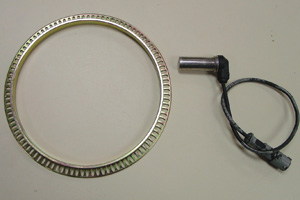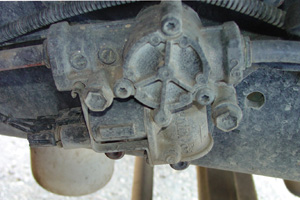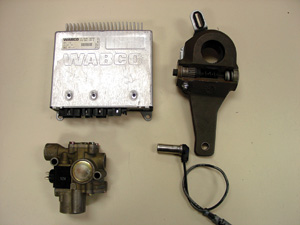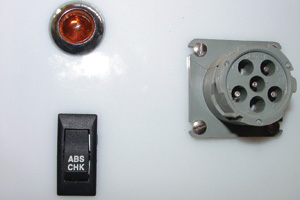
Equipment
Truck Checks: ABS for the fire service
A little history to start: Antilock Brake System (ABS) for vehicles is not a new idea. The first practical application was developed for the railroad industry in the early 1940s and then later for the aircraft industry in the late 1940s and 1950s.
November 14, 2008
By Don Henry
A little history to start: Antilock Brake System (ABS) for vehicles is not a new idea. The first practical application was developed for the railroad industry in the early 1940s and then later for the aircraft industry in the late 1940s and 1950s. An early attempt at ABS for heavy trucks was made in the 1970s and was a failure for a number of reasons. Suffice to say that the idea was good but the technology had not yet matured. It should be noted that at this time the only official federal stopping distance was 35 feet at 25 mph. The NFPA 1910 standard for many years has been 35 feet at just 20 mph. That is why I stress that NFPA is a minimum standard. These early systems were hampered by slow analog computers, radio frequency interference and a lack of an effective system diagnosis. Federal Motor Vehicle Safety Standard (FMVSS) was amended in 1995 to require ABS on air-brake tractors, trucks and trailers and buses in the United States. The effective dates were March 1, 1997, for tractors and trucks; one year later for buses and trailers. In Canada, the regulation did not come into effect for heavy trucks until March 1, 1998. Because many fire truck chassis are made in the U.S., the fire service got the benefit of the earlier U.S. regulation. It should be noted that as early as 1987, Freightliner Corp. offered the new WABCO 6 channel ABS as an option on heavy trucks, years before it was the requirement.
 |
| Figure 1: Wheel speed sensors and tone rings Photo by Don Henry |
 |
| Figure 2: Modulator valve mounted on truck frame Photo by Don Henry |
 |
| Figure 3: ABS computer (upper left) automatic sack adjuster (upper right) modulator valve, (lower left) and speed sensor (lower right). The slack adjuster has been cut away as a training aid. Photo by Don Henry |
 |
| Figure 4: Blink code light, ABS check switch and data link connector Photo by Don Henry |
What does ABS do? Simply put, the ABS does not allow the wheels to lock up during an aggressive stop. The braking system provides the best (shortest) stopping distances just before the wheels lock up. On older vehicles, you may have noticed that the wheels lock up when you applied the brakes too hard as you approached an icy intersection during the winter. As the vehicle began to slow down, your inner ear gave the sensation of slowing down, but if you pushed the brake pedal harder, the wheels would lock up. You began slowing down at a different rate, and your inner ear gave you the sensation that you were, in fact, speeding up. Of course, you were not actually speeding up; you were just slowing down at a different rate. Why did this occur? Because the best traction while stopping is at the instant before the wheels lock up. The other great feature of ABS is that you are able to maintain steering control during an aggressive stop. Once again, the older, non-ABS would not let you change direction during an aggressive stop. During an aggressive stop, non-ABS would lock up the wheels and you went where you were last pointed (following Newton’s first law of motion). There are a number of other benefits of ABS, such as a lack of flat spotting of tires and, for departments that use trailers as water tankers, minimization of trailer jackknifing.
How does it work? Take a normal functioning air brake system and add air solenoid modulator valves, computers, tone rings and wheel speed sensors.
■ Wheel speed sensors and tone rings
The wheel’s speed sensors measure the rotational speed of the tone rings mounted on the wheel hub. The tone rings induce a voltage into the wheel speed sensor. This induced voltage is an AC voltage that gets higher in voltage and frequency as the vehicle goes faster. This voltage is very weak and any poor electrical connection causes problems. The tone rings can get contaminated with grease, mud, oil or dirt. If contamination occurs, the wheel speed sensor may not be able to actually detect the speed of the wheel. This would then cause the ABS code light on the dash to come on. If all the tires are the same size, inflation pressure is the same and all wheels going the same speed, then the wheel speed sensors signals being sent to the computer should be very close to the same. As the vehicle makes a normal stop, all the wheels should slow down at nearly the same speeds and the ABS does not even come into play. However, if the stop is aggressive, then a wheel on ice may begin to slow in rotational speed faster than the other wheels. This would indicate to the ABS computer that this slower wheel is beginning to lock up. In other words, the amount of air pressure being applied to that brake chamber is too much and this is
causing that wheel to lock up. The air pressure to that one brake chamber will need to be exhausted very rapidly. This is the job of the modulator valve. The releasing of this air pressure causes this wheel to slow down at a slower rate and brings its speed in line with the other wheels. This ensures that the wheel does not lock up (skid). Therefore, you can maintain steering control during very aggressive stops. This modulator can cycle up to five times a second. This ensures a smooth application and release of the brakes.
■ Modulator valves
The job of the modulator valve is to release air pressure from wheels that are about to lock up. It is important to understand that even if all power were cut to the modulator valves, the brakes would work like a normal non-ABS. In my experience, the most common cause of problems is electrical, so look for poor connections allowing water in, which causes corrosion or poor (high) resistance grounds. NFPA 1901 does not allow star-type washers on ground connections; they tend to cause problems later on during the service life of the truck.
Remember that all this great new technology will not work if you are not draining the air tanks to remove moisture build up. While an air dryer is great, you know that it is working only if you personally drain the air tanks. Most fire halls are very moist places, and the air is often saturated with moisture. An on-board air compressor is a wonderful device to keep the air pressure up, but who is draining the water from the tank it is pumping into? Is the automatic drain working?
■ ABS computer
The ABS computer is a solid-state device that contains no user serviceable parts. Do not drill holes in it when you install radios. It is recommended by the manufacturer that you disconnect the computer before welding on the truck but you should do that with all the computers, engine, transmission and electronic pump control. Don’t just disconnect the batteries; disconnect the computer from its wires.
How do you know the ABS system is working? The computer has self diagnostic capabilities. First, start the vehicle. As you turn the key on or power up the truck, you should notice some very distinctive clacking sounds. This is the ABS solenoid going through the start-up procedure. Depending on which system you have and the number of axles, this should take only a few seconds. If everything is right, the ABS light on the dash of your truck will come on and then go out. This is known as an ABS operational brake check. It should be noted that even if you had a complete or partial failure in the ABS system, you would revert back to a normal air brake system. NFPA 1911 sets the out-of-service critical for fire apparatus; brakes are covered in 6.8.1.1-2. If you have an ABS warning light indicator, a qualified technician shall conduct an out-of-service evolution and make a written report.
What sort of problems cause the ABS light to come on? One very common problem is the wheel’s speed sensors. The wires get pulled off or can get burned off at grass fires. After you reconnect the wire, you will need to drive the truck at least five to six km/h for just a few feet. This will allow the wheel speed sensor to send a signal to the ABS computer and turn off the ABS light on the dash. Simply fixing the problem without driving the unit will not make the light go out. It is possible to retrieve these trouble codes without expensive equipment. If you have an ABS dash light on all the time, then you have an active trouble code. Find the blink code switch, which is located on the dash close to the light (or it can be located on or close to the ABS computer). This computer can be located on the frame rails under the cab or under the dash. Follow the manufacturer’s recommended procedures. With the engine off, wheels chocked, master electrical switch on and the unit not moving, turn on the engine key. After the unit has cycled the modulator air valves, press and hold the blink code switches for three seconds, then release. The dash light will flash twice, then six times, then 12 times. The two flashes mean you have a 4s/4m system, which means four speed sensors – one for each wheel – and four modulator valves, one for each brake. This is very common for most single-axle fire trucks. It is the last two numbers that actually give you the information to locate and fix the problem. In this case, the six flashes and the (12) tell you that the right, front steering axle wheel speed sensor is out of adjustment. If you get a 2-7-0 code, check for loose wheel bearings on the left rear wheel. The codes are available from both the Meritor-Wabco website (www.meritorwabco.com/literature/default.asp) and the Bendix site (www.bendix.com/en-us/service/library/Pages/Multimedia.aspx). While there are some differences between these two major manufacturers, once you understand one, understanding the other is simple. You can, of course, connect your laptop computer to the ABS systems and retrieve additional information such as voltages. You can also test components like the modulator valves, traction control and other functions. Remember that simple codes can be obtained with just the blink code switch and the ABS dash light.
■ Automatic slack adjusters
Another area of concern is the automatic slack adjuster angle. I think we have become slack about checking the slack adjusters. For the most part, the automatic slack adjusters work well, but they need to be checked daily as part of regular and complete air brake inspections. This is the duty of the driver. If they are working correctly, they should not need to be adjusted. (Please read my previous columns on slack adjuster angle.) If your self-adjusting slack adjusters are not readjusting themselves, it may be because you are too good a driver. Let me explain. Many slack adjusters need a solid 100 psi brake application to readjust themselves. Many expert drivers use a combination of good driving skills and the engine or transmission brake to slow down the vehicle and, therefore, may need only 20 to 30 psi brake applications. If the brakes do not receive a 100 psi application occasionally, they will not re-adjust on some models. Naturally, you would never want to make such an aggressive stop on a major road with other firefighters in the cab. It is best to make this solid brake application while in the fire hall, as part of your daily brake inspection. While you are making this application, have someone walk around the truck to listen for any air leaks from hoses, fittings or air-brake components. Like all things mechanical, automatic slack adjusters can fail. Failure is usually caused by lack of greasing. The grease zerks are there for a reason. If the slack adjusters seize up and do not self adjust, a very dangerous problem can arise. Let us assume that three of the four automatic slack adjusters are defective and not adjusted correctly. These brakes would be ineffective. If the driver now makes an aggressive brake application, the ABS computer will look at the respective wheel sensor speeds. The only good brake will be slowing down its wheel much faster than the rest of the wheels on the truck. As the driver realizes that he is not slowing down the truck as fast as he would like, he will naturally push harder on the brake pedal. The ABS will detect that the adjusted brake is slowing down too fast and about to lock up the wheel. To compensate for this lock up, the ABS computer will exhaust air from the only good brake that the driver has. How do I know this? I have done it at our fire training school on its driving tract. I miss-adjusted the brakes on three wheels on purpose and then I went for a drive on a rain-slicked road at the fire school.
While the present ABS used on trucks is very good, it does not know if the slack adjusters are defective. Make sure that you inspect the slack adjuster angle daily.
In conclusion, I am a big believer in ABS. The problem will come in a few years when departments have a mixed fleet of ABS and non-ABS trucks. Drivers could come to depend on the ABS and when they have to drive an older reserve or spare unit that does not have ABS, they could be in for a big surprise. I hope this article gets your department ready for the winter driving conditions we have come to expect in this country.
I would like to thank all the departments that commented back to me on the article on bio diesel and asked for the PowerPoint presentation. For those departments that were forced to use bio diesel, best of luck to you.
Don Henry teaches in the Automotive Services Technician and Heavy Equipment Technician programs at Lakeland College in Vermilion, Alta. He can be reached at don.henry@lakelandcollege.ca
Print this page